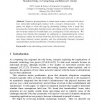Free Online Productivity Tools
i2Speak
i2Symbol
i2OCR
iTex2Img
iWeb2Print
iWeb2Shot
i2Type
iPdf2Split
iPdf2Merge
i2Bopomofo
i2Arabic
i2Style
i2Image
i2PDF
iLatex2Rtf
Sci2ools
HUC
2007
Springer
2007
Springer
How Smart Homes Learn: The Evolution of the Networked Home and Household
Despite a growing desire to create smart homes, we know little about how networked technologies interact with a house’s infrastructure. In this paper, we begin to close this gap by presenting findings from a study that examined the relationship between home networking and the house itself—and the work that results for householders as a consequence of this interaction. We discuss four themes that emerged: an ambiguity in understanding the virtual boundaries created by wireless networks, the home network control paradox, a new home network access paradox, and the relationship between increased responsibilities and the possibilities of wireless networking.
| Added | 07 Jun 2010 |
| Updated | 07 Jun 2010 |
| Type | Conference |
| Year | 2007 |
| Where | HUC |
| Authors | Marshini Chetty, Ja-Young Sung, Rebecca E. Grinter |
Comments (0)

